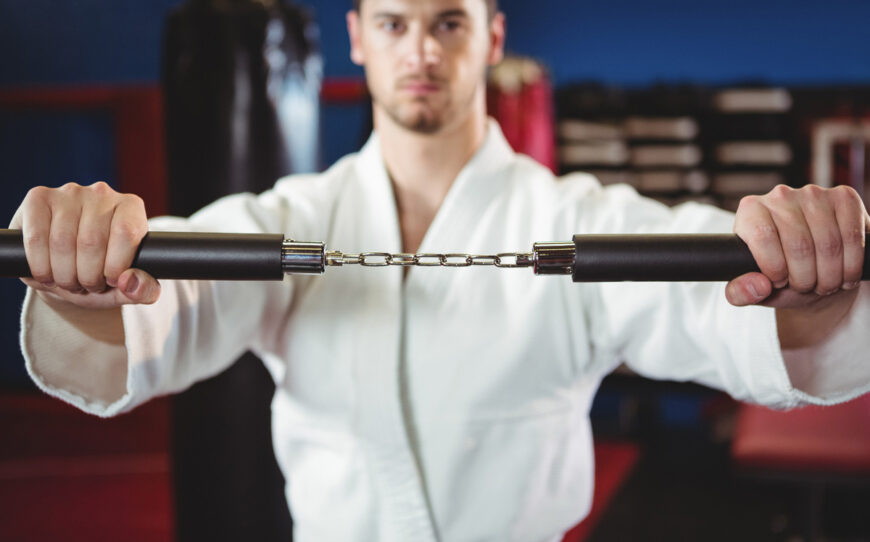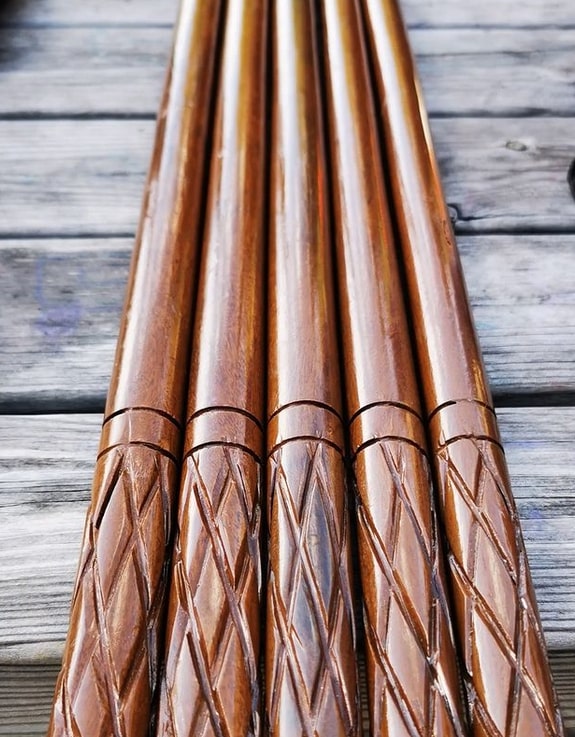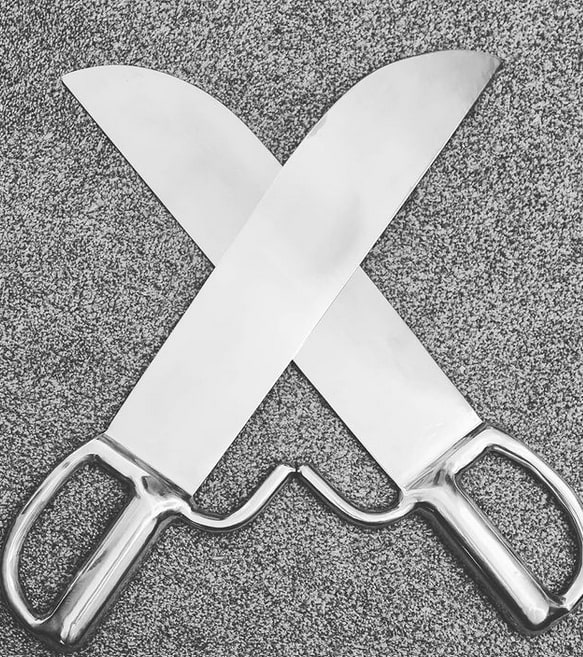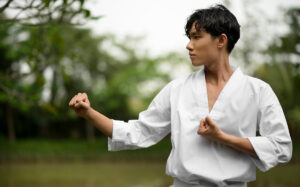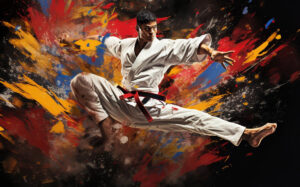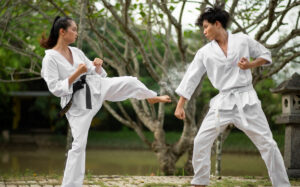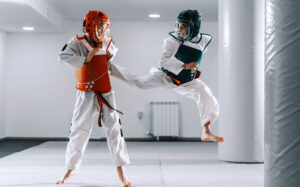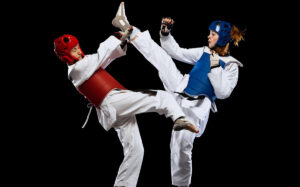In martial arts, weaponry significantly enhances one’s skills and increases the effectiveness of self-defense techniques. Although not traditionally weapon-focused, Taekwondo has adapted various tools from other martial arts styles. Taekwondo weapons can complement your training and elevate your overall performance.
This comprehensive guide focuses on the best Taekwondo weapons. We will introduce you to various sticks and blades designed for different skill levels and purposes.
Key Takeaways
- Taekwondo offers a wide range of weapons to enhance training and self-defense skills.
- Each weapon has unique features and benefits, from the Bo Staff for balance to the Kama for precision.
- When choosing a Taekwondo weapon, consider personal preference, skill level, intended purpose, weight, and material. Fighting style and legal restrictions also matter.
- Proper technique and form are crucial for safety and effectiveness when practicing with martial arts weapons.
Types of Taekwondo Weapons and Their Uses
Taekwondo offers a wide range of weapons. It includes the Bo Staff for defense and balance and Eskrima Sticks for versatility and coordination.
Nunchucks for speed and agility, Kama for precision and control, and Sai or Tridents for focus and precision. Shurikens/Bolo Knife/Teko-Kagis/Tonfas, Butterfly Swords/Tiger Hook Swords/Katana/Jian for traditional martial arts.
Bo Staff For Defense and Balance
The Bo Staff is a versatile and essential weapon for improving defense, balance, and overall martial arts skills. This long wooden staff extends the practitioner’s body and is commonly used in martial arts like Taekwondo, Karate, and Kung Fu.
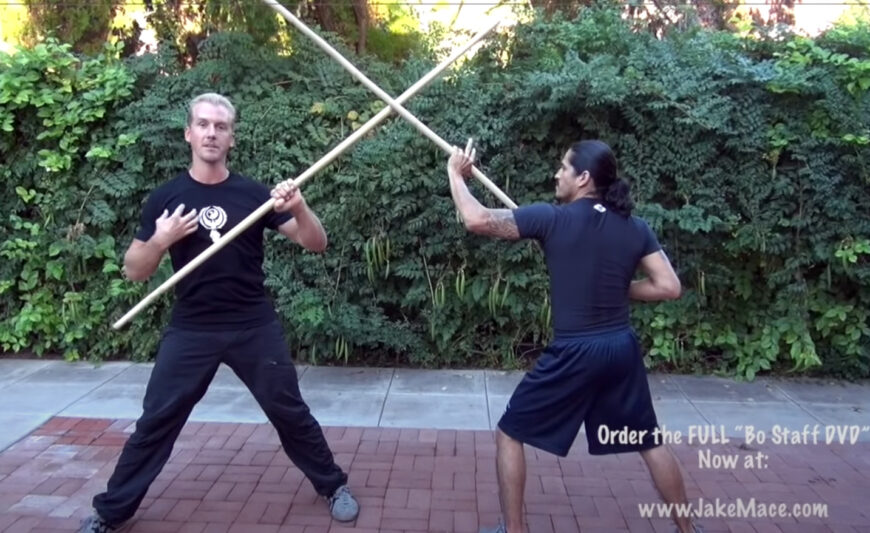
Incorporating the Bo Staff into your Taekwondo training can help develop greater stability. It strengthens the core muscles that maintain proper posture during high-intensity movements.
Practice different stances and execute complex strikes with precision using this traditional weapon. You’ll increase your agility and proprioception – the awareness of your body’s position in space.
Furthermore, mastering a Bo Staff can teach practitioners to disarm opponents with longer weapons. It also teaches them to maintain a safe distance while engaging in combat.
Eskrima Sticks For Versatility and Coordination
Eskrima sticks, or Bahng Mahng Ee or Kali sticks, are a versatile and highly effective martial arts weapons. Originally from the Philippines, these lightweight rattan sticks are typically 28 inches long and used in pairs.
Martial artists favor Eskrima sticks for their ability to improve coordination, agility, and precision through various striking patterns, blocks, disarms, and locks.
The fluid movements developed by training with these weapons translate well into other areas of martial arts practice. For instance, Taegeuk Pal-Jang – an advanced form of Taekwondo – contains techniques that resemble Filipino stick fighting methods.
Incorporating Eskrima sticks into your regular Taekwondo training routine will enhance your overall skillset. It will foster an appreciation for the unique qualities found within different martial arts disciplines.
Nunchucks For Speed and Agility
Nunchucks, or Nunchaku or Sang Jeol Bong in Taekwondo, are versatile and agile weapons. It has gained popularity among martial arts enthusiasts due to its speed and versatility.
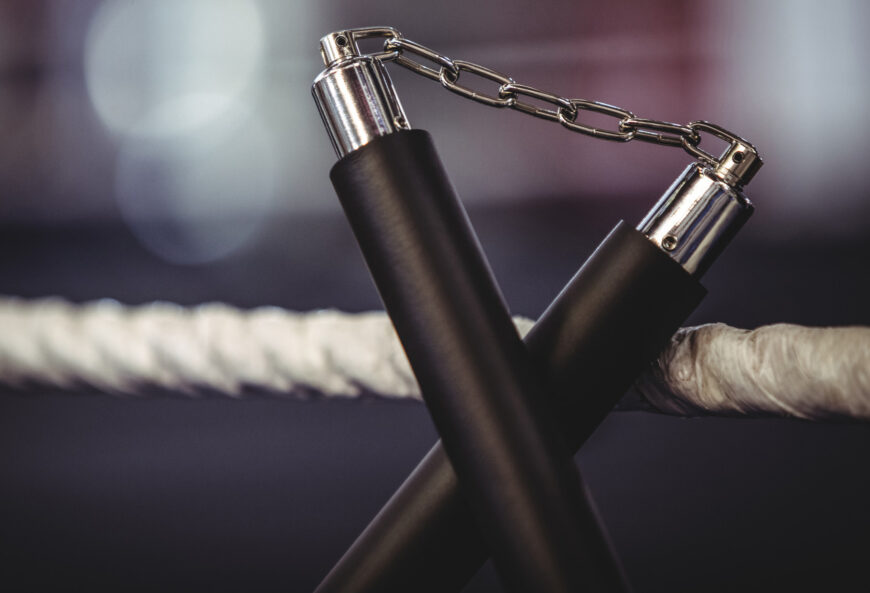
The intricate movements required to control nunchucks effectively make them the perfect tool for developing agility and quick reflexes. Besides improving hand-eye coordination, mastering the art of wielding nunchucks helps increase muscular strength and dexterity.
Incorporating this fast-paced weapon into your Taekwondo practice can add an exciting new dimension to your traditional training regimen. It enhances self-defense techniques against potential armed attackers.
Kama For Precision and Control
Kamas are among the most common weapons used in martial arts and were originally farming tools. They consist of a small, handheld sickle with a sharp blade. It can be used for precision cuts and control during combat.
One interesting fact about kamas is that farmers in Okinawa used them to harvest crops like sugar cane. When farmers needed to defend themselves from bandits or animals, they used the kama as an improvised weapon.
Today, many martial artists use kamas not only for self-defense but also for artistic demonstrations and competitions.
Sai Or Tridents For Focus and Precision
The Sai, or tridents, is a traditional Okinawan weapon for thrusting and blocking. Its three-pronged design requires a great deal of focus and precision to master.
The Sai can be used in self-defense, with the prongs used to disarm or immobilize an attacker. It can also be thrown at opponents or used in close-range fighting.
The Sai originally started as a farming tool used for planting rice. It was later adapted into a weapon by Okinawan farmers during the conflict.
Shurikens/Bolo Knife/Teko-Kagis/Tonfas
Shurikens, Bolo Knives, Teko-Kagis, and Tonfas are martial arts weapons in taekwondo. The shuriken is a small throwing weapon typically used for long-range attacks.
The bolo knife is a heavy cutting tool with a curved blade. It can be used in close combat and projectile attacks. The teko-kagi is another short-range weapon with claw-like blades worn on the hand for quick strikes and grappling techniques.
While these weapons require specific skill sets to master, incorporating them into your taekwondo practice can improve overall balance, precision, and coordination. Consider personal preference and experience when choosing which weapons to incorporate into your training regimen.
Butterfly Swords/Tiger Hook Swords/Katana/Jian For Traditional Martial Arts
Butterfly Swords, Tiger Hook Swords, Katana, and Jian are traditional martial arts weapons used for centuries. These weapons require a high level of skill and precision to master and can be challenging for beginners.
The Butterfly Swords, or “hudiedao,” were originally developed as a concealed weapon in southern China.
Chinese infantry soldiers often used the Tiger Hook Sword, or “hooked swords,” during the Ming Dynasty. This weapon’s hook-like blade allows its wielder to disarm opponents’ weapons while maintaining an offensive posture.
Similarly, the Katana is a curved sword that originated from Japan and was mostly used by Samurai warriors. It requires extensive training to master its precise movements and techniques effectively.
These traditional martial arts weapons offer practitioners variety based on cultural differences in the origin story. All offer exciting opportunities for those skilled enough to use them correctly. They add complexity to any sophisticated martial arts practice beyond just kicking footwork alone!
Factors To Consider When Choosing A Taekwondo Weapon
Consider personal preferences, intended purpose, skill level, weight and material of the weapon, fighting style, and legal restrictions.
Personal Preference and Comfort
Choosing the right taekwondo weapon largely depends on individual preference and comfort. Selecting a weapon that feels comfortable in your hands and complements your fighting style is important.
If you prefer a fast-paced combat style, traditional weapons like nunchucks or kamas may suit you.
Consider how well a martial arts weapon fits into your body mechanics. After all, using a weapon should amplify your physical strength rather than hinder it.
Purpose of Use
When choosing a taekwondo weapon, consider its purpose of use. Some weapons are better suited for self-defense, while others are ideal for competitions or exhibitions.
For instance, the Bo Staff is a versatile and practical weapon for attack and defense in taekwondo sparring matches.
Some weapons, like the Kama or Sai tridents, are designed primarily for precision and control during demonstrations or form contests. These weapons require technical skill to execute complex movements fluidly.
Ultimately choosing a taekwondo weapon should depend on an individual’s goals within this martial art style.
Skill Level
The skill level of a practitioner must be considered when choosing a taekwondo weapon. Beginners may find handling more complex weapons like the kama or nunchucks challenging. Intermediate and advanced practitioners can benefit from using these weapons for precision and speed.
Choosing a weapon that matches your skill level is important so you can train safely and effectively. As your skills progress, you can start incorporating more intricate techniques into your practice.
Weight and Material
The weight and material of a taekwondo weapon are important factors to consider when choosing your weapon. The weight should be comfortable to wield. It should not be too heavy to slow you down or too light that it lacks impact.
As for the material, most weapons are made from wood, metal, or synthetic materials. Wooden weapons, like the bo staff, offer balance and control, while metal, like the katana, provides durability and precision.
Finding the right balance between comfortability, durability, precision, and safety is essential. A lightweight weapon can improve agility. The heavier ones are good at taking out opponents with one hit but may limit speed.
Suppose you’re an intermediate-level practitioner looking to improve coordination skills through close-combat fighting styles like Eskrima sticks or Tonfa. Wooden materials will do better than metallic types with their ease of use during partner sparring drills.
Fighting Style
Your chosen fighting style plays a significant role in selecting the right taekwondo weapon. If your fighting style emphasizes speed and agility, then Nunchucks might be ideal. They enable quick strikes and movements.
Traditional martial arts practitioners may prefer Butterfly Swords or Jian swords. It is for their historical significance and aesthetic appeal. Consider legal restrictions on specific weapons in your region, too before choosing.
Legal Considerations and Restrictions
Before training with a taekwondo weapon, understand your area’s legal considerations and potential restrictions.
Certain weapons may be prohibited or require special licensing for possession or use. For example, nunchaku is illegal in several states within the United States. It is due to public safety concerns.
When choosing a taekwondo weapon to train with, research and consult with local authorities. It will ensure that the weapon is legal and safe for use in your area.
You must also learn proper handling techniques and exercise caution when using weapons during training. This is because injuries can occur even among advanced practitioners.
Tips For Training With Taekwondo Weapons
Train with taekwondo weapons safely and effectively by following these tips.
Safety Precautions
To ensure your safety while training with taekwondo weapons, take the following precautions:
- Always wear appropriate protective gear, like padded gloves, eye protection, and headgear.
- Train under the supervision of a qualified instructor who can guide proper techniques and form.
- Use only approved weapons and equipment that are in good condition.
- Never use weapons without proper training and instruction.
- Always practice in a safe, open area without obstacles and hazards.
- Keep your weapons properly stored and secured when not in use to prevent accidents or theft.
- Avoid practicing near other people who are not trained or using weapons to prevent accidental injuries.
- Be mindful of your surroundings while training with weapons, especially if using sharp or pointed objects.
- Do not attempt advanced techniques or moves until you have mastered the basics and feel confident.
- If you’re feeling fatigued during a training session, take a break to rest and recover before continuing.
By following these safety precautions, you can minimize the risk of injury while training.
Proper Techniques and Form
Proper techniques and form are essential when using taekwondo weapons. Whether you’re a beginner or an expert, learning how to handle each weapon is important.
When using nunchucks, maintain proper wrist control while twirling the weapon. This not only ensures your safety but increases your accuracy as well.
By mastering techniques like grip strength and footwork, you can become proficient with your chosen weapon. Partner drills also help develop coordination, timing, and accuracy in execution.
Choosing a suitable martial arts weapon according to personal preference is important. This will affect your comfort level while practicing techniques regularly.
Partner Drills For Skill Building
Partner drills help you learn how to effectively use taekwondo weapons. Working with a partner allows martial arts practitioners to develop their timing, accuracy, and coordination. It builds their confidence in using various weapons under pressure.
Partner drills can also simulate real-life combat situations where self-defense tactics come into play. Practitioners can practice disarming an opponent wielding a weapon like a knife or a sword by using joint locks and throws.
Choosing The Right Training Program
Choose the right training program for Taekwondo weapons. Look for teachers with experience teaching weapon techniques and take classes focusing on your chosen weapon.
Consider your skill level and personal preferences when choosing a training program. Beginners may benefit from starting with lighter or simpler weapons like the short stick or combat cane. More advanced practitioners may want to challenge themselves with more complex weapons like hook swords or kama.
Incorporating Weapon Training Into Your Overall Martial Arts Practice
Incorporating weapon training into your overall martial arts practice enhances your skills and provides you with new challenges to overcome. Start with the basics, mastering basic strikes and moves before moving on to more advanced techniques.
Remember that not all martial arts styles use weapons in their practice. If you want to incorporate weapons into your routine, research which styles utilize weaponry to find the best fit.
Top 3 Best Taekwondo Weapons For Beginners, Intermediate, and Advanced Practitioners
To help martial arts and MMA fans determine the best Taekwondo weapons to suit their skill levels, we’ve compiled a list of the top three weapons. They are suitable for beginners, intermediate, and advanced practitioners.
|
Skill Level |
Weapon |
Description |
Benefits |
|
Beginner |
Bo Staff (Jahng Bong) |
A long wooden staff is used for defense and balance. |
Improves balance, coordination, and defense techniques. It’s a versatile weapon that’s easy to learn and master for new martial artists. |
|
Intermediate |
Eskrima Sticks (Bahng Mahng Ee) |
Paired wooden sticks are used for versatility and coordination. |
Develops hand-eye coordination, speed, and offensive/defensive tactics. They’re lightweight and easy to carry, making them a great choice for intermediate practitioners. |
|
Advanced |
Nunchucks (Sang Jeol Bong) |
Two short sticks connected by a chain or rope are used for speed and agility. |
Increases speed, agility, and reaction time. Requires high levels of skill and precision to master, making them ideal for advanced practitioners. |
FAQs
1. What Are The Best Taekwondo Weapons For Beginners?
Starting with simple and easy-to-use weapons like nunchucks, bo staffs, or escrima sticks is recommended for beginners in Taekwondo. These weapons provide a strong foundation upon which more complex techniques can be built over time.
2. Are There Any Age Restrictions On Using Taekwondo Weapons?
Due to safety concerns, most schools and training centers have specific guidelines and policies on using certain martial arts weaponry. This depends on the student’s age group. Parents must consult with their child’s trainer before purchasing any equipment.
3. How Do I Choose The Right Weapon For My Skill Level?
Choosing the right weapon depends on an individual’s skill level, experience, and physical attributes. Trainers will consider factors like height/strength while recommending specific types/styles based on student abilities & developments. It ensures they stay challenged yet are not overwhelmed by new skills.
4. Is Owning Your Own Taekwondo Weapon Necessary For Personal Practice?
Owning one’s own set of martial arts weaponry isn’t necessary per se when starting. Those interested in progressing through the ranks may benefit from additional resources outside class times (i.e., practicing drills/forms/katas).
They can explore different styles/techniques seen throughout social media channels. This accelerates learning without relying solely on guidance provided by the instructor during classes.
Conclusion
Incorporating weapons training into your taekwondo practice can greatly enhance your skills and add variety to your workouts. When looking for the right weapon, consider personal preference, skill level, and purpose of use.
Proper technique and form are crucial for safety and effectiveness when training with martial arts weapons. Whether you’re a beginner or an advanced practitioner, there’s no shortage of options for taekwondo weapons.
Learn More About Taekwondo
- Basic Taekwondo Forms To Master: Unlock Your Inner Warrior
- Taekwondo Vs Karate: The Ultimate Showdown
- Taekwondo Kicks: Learn Everything About The Kicks In Taekwondo
- Top 10 Greatest Taekwondo Players of All Time
- Best Martial Arts for Streetfight: Unleash Your Inner Warrior
- Best Taekwondo Schools in the World
- Top 21 Deadliest Martial Arts in the World According to Experts
- Taekwondo Belt Levels and Ranking Guide
- Taekwondo Stances

